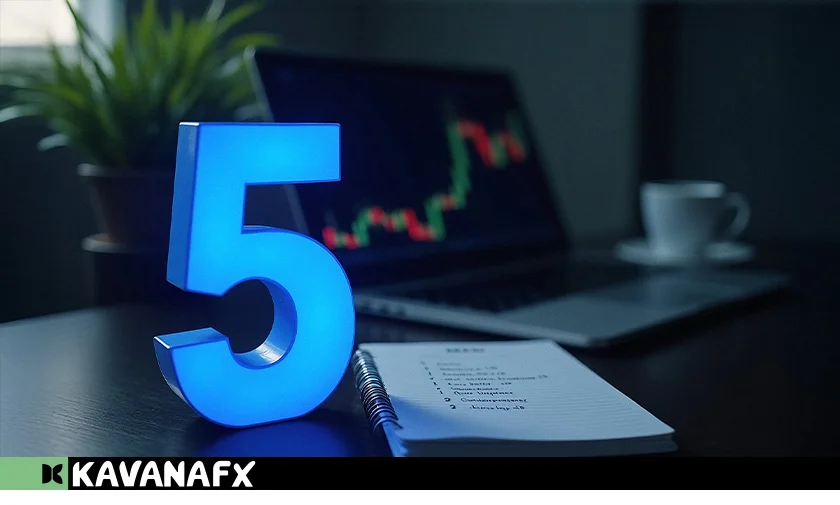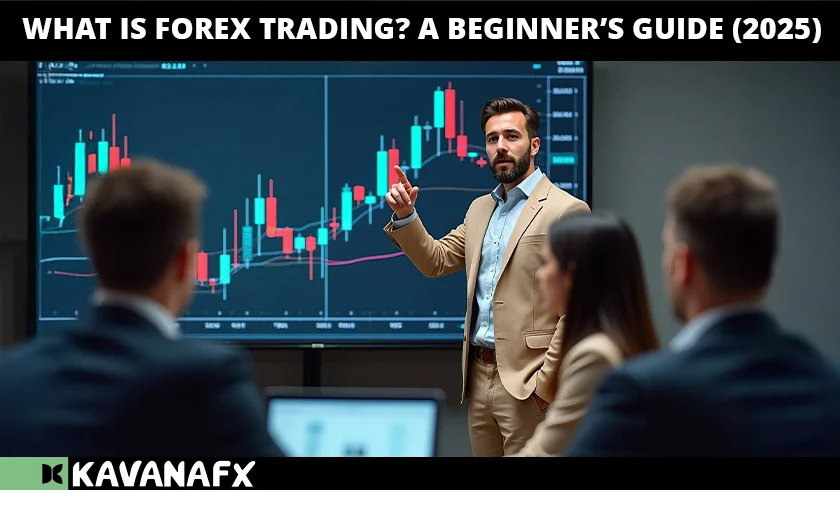Welcome to the world’s biggest financial market: Forex. With an astonishing $7.5 trillion+ in daily trades (BIS 2024 Survey), forex operates 24 hours a day, 5.5 days a week across major global financial centers.
If you’re interested in learning how to trade forex, this 2025 guide is your essential introduction. We’ll make the essentials easy, explain basic concepts, and provide you with step-by-step action plans to begin – perfect for anyone looking to begin forex for beginners.
What Exactly is Forex Trading?
Forex (FX), or foreign exchange, is the global marketplace for exchanging one currency for another. It’s a decentralized market — meaning there is no central exchange. Instead, forex is traded over-the-counter (OTC) via a network of banks, brokers, and institutions.
Unlike stocks or commodities, forex trading revolves around currency pairs, where one currency is bought while another is simultaneously sold.
The Core Idea:
You speculate on the relative value of one currency against another.
• Buy if you believe the base currency will rise
• Sell if you expect it to fall compared to the quote currency
How the Forex Market Works
The forex market is structured across three main trading sessions:
• Asia (Tokyo)
• Europe (London)
• North America (New York)
These sessions overlap, creating near-continuous trading and unmatched liquidity. The forex market remains open 24 hours a day, Monday to Friday, allowing traders worldwide to participate at any time.
Major participants include:
• Central banks (e.g., the Federal Reserve, ECB)
• Commercial banks
• Multinational corporations
• Hedge funds
• Retail traders (like you)
Currency Pairs: The Building Blocks
Currencies are always traded in pairs, for example, EUR/USD (Euro vs. US Dollar) or USD/JPY (US Dollar vs. Japanese Yen).
• Base Currency: The first currency in the pair
• Quote Currency: The second currency in the pair
• Exchange Rate: Shows how much of the quote currency is needed to buy one unit of the base
Example: EUR/USD = 1.1200 means 1 Euro = 1.12 US Dollars.
Key Trading Terms
• Pip: The smallest price movement in a pair (0.0001 for most pairs; 0.01 for JPY pairs)
• Spread: The difference between the bid and ask price
• Lot Size: Trading volume; a standard lot is 100,000 units
Types of Currency Pairs
1. Majors: Most traded; include the USD
- e.g., EUR/USD, USD/JPY
2. Minors (Crosses): Don’t include USD
- e.g., GBP/JPY, AUD/CAD
3. Exotics: Emerging market currencies paired with majors
- e.g., USD/TRY, EUR/ZAR
Tip: Beginners should stick to major pairs — tighter spreads, lower volatility, and more predictable behavior
Types of Forex Markets
Forex is traded through different types of contracts:

1. Spot Market
• Instant exchange of currencies
• Retail traders mostly access this market via brokers and CFDs
2. Forward Market
• Private contracts between parties for future delivery
• Often used by corporations to hedge
3. Futures Market
• Standardized contracts traded on exchanges like the CME
• Used by institutions
4. Options Market
• Provides the right, not obligation, to buy/sell at a future date
• More complex and less common among beginners
5. CFDs (Contracts for Difference)
• Most retail forex trading is actually CFD-based
• You speculate on price direction without owning the actual currency
• Leverage, short selling, and low capital requirements make CFDs popular
Why People Trade Forex (and Risks)
Pros
• High Liquidity: Especially in major pairs
• Low Entry Barrier: Start with small capital
• Leverage Access: Amplifies trade size
• 24-Hour Market: Flexible for any time zone
• Two-Way Market: Profit from rising or falling prices
Risks
• Leverage Cuts Both Ways: It magnifies both gains and losses
• Market Volatility: News and economic events move prices fast
• Psychological Pressure: Emotional trading can cause major losses
• Regulation Matters: Only trade with a regulated broker to avoid scams
Your 5-Step Roadmap to Start Forex Trading

1. Educate Yourself Thoroughly
Understanding market mechanics is your foundation.
• Learn core concepts: pip, lot, spread, leverage, margin
• Study Fundamental Analysis: interest rates, economic reports, central banks
• Study Technical Analysis: candlestick charts, support/resistance, indicators
2. Choose a Trusted Regulated Broker
Pick a broker regulated by major authorities (FCA, ASIC, CySEC, FSCA). Your broker connects you to the market, so trust is critical.
Checklist:
• Offers demo account
• Competitive spreads
• MT4, MT5 or custom platform
• Responsive customer support
• Negative balance protection
3. Develop a Solid Trading Plan
Your trading plan is your guide under pressure.
• Define your goals (e.g., income, learning, skill-building)
• Choose a style: scalping, day trading, swing, or long-term
• Pick a strategy (breakouts, indicators, news-based)
• Define risk rules: 1% per trade, daily loss limits
• Limit focus to 2–3 major pairs
Pro Tip: Use a trading journal to log:
• Why you entered a trade
• Entry/exit
• Outcome
• Emotions and takeaways
4. Practice with a Demo Account (Seriously)
Demo trading simulates real markets with zero risk.
• Get familiar with placing orders: market, stop, limit
• Test strategies and build muscle memory
• Track performance over weeks/months
• Build confidence and control emotions
5. Go Live — Slowly
After demo consistency:
• Start with micro lots
• Use low leverage (5:1 or lower)
• Keep emotions in check
• Stick to your rules — no exceptions
Track every live trade in your journal
Review weekly for patterns and improvement.
Tools You’ll Want to Use
| Tool | Purpose |
| Economic Calendar | Track major events(CPI, rate decisions) |
| Trading Platform | Charting, orders, automation |
| Position Size Calculator | Manage risk per trade |
| Forex News Feeds | Stay updated(DailyFX, Forex Factory) |
| Trading View | Advanced chart analysis |
Mini Glossary
| Term | Definition |
| Pip | Smallest price movement (0.0001 for most pairs) |
| Leverage | Borrowed capital to increase trade size |
| Lot | Unit of trade |
| Stop-loss | Auto-close at loss limit |
| Take-profit | Auto-close at profit level |
| Spread | Difference between buy/sell price |
| Margin | Required capital to open a position |
Start Right, Grow Steadily
Forex trading offers massive opportunity — but only for those who respect the process. It’s not a get-rich-quick game. It’s a skill you build.
By learning the basics, understanding risk, choosing a trustworthy broker, and practicing with a demo account, you’ll lay the right foundation.
Take it slow. Learn with intent. Master your discipline.
Ready to Trade Without Risk?how to trade
Practice Makes Profit
Open your free demo account and test your skills in real-time markets.
- No risk.
- No commitment.
- Instant access.
